A dynamic electrocardiogram is also known as a named”Holter”;, and many people vividly call it a “backpack electrocardiogram”. It can record your electrocardiogram waveforms for 24 hours in different positions such as resting, moving, standing, lying, and sitting.
These waveforms are continuously recorded in the recorder, and then the data stored in the recorder is input into the computer. After comprehensive analysis, the pattern of electrocardiogram changes is obtained, and transient arrhythmias and transient myocardial ischemic attacks that are not easy to detect with conventional electrocardiograms are “identified” to reduce missed diagnoses. It solves the problem of your frequent palpitations, which are often not found with conventional electrocardiograms.
If your conventional electrocardiogram (ECG) test results are normal, but you suspect that you have coronary heart disease, arrhythmias, etc., you should undergo dynamic electrocardiogram monitoring. Holter (DCG) has a high detection rate in clinical applications, especially for early coronary heart disease. Its clinical value in capturing transient myocardial insufficiency and arrhythmia and diagnosing early coronary heart disease is much higher than that of ordinary electrocardiogram, especially in people with normal ordinary electrocardiogram, a large number of abnormal dynamic electrocardiograms are still found. Therefore, in clinical practice, for some patients with atypical chest tightness, palpitations, dizziness and other symptoms, if the ordinary electrocardiogram is normal, dynamic electrocardiogram examination should be performed as soon as possible to identify the cause as soon as possible and carry out targeted treatment.
Post time: Jun-27-2025











